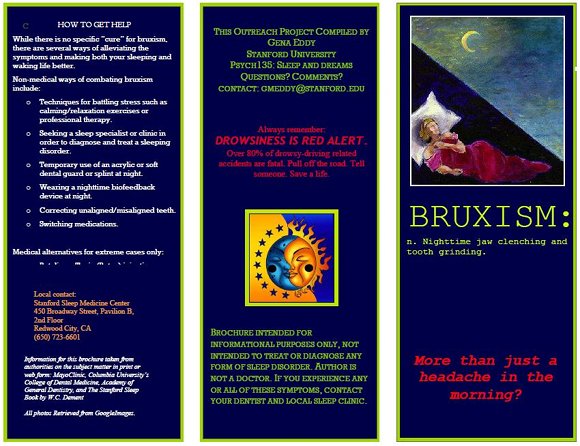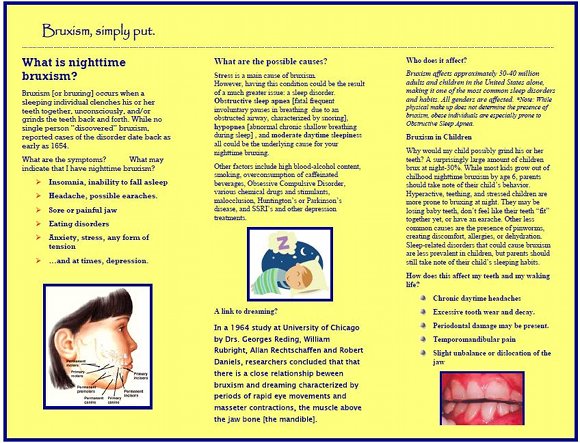
| Connect & Subscribe |
Bruxism Brochure - More Than Just A Headache In The Morning?
An Outreach Project by Gena Eddy | Return To Outreach Projects 2010
The following is a brochure created for Stanford Sleep and Dreams. If it is difficult to read using the images, you may view the full text here.
Also feel free to download this brochure for distributional or general information purposes. Please refer to our privacy policy for our relevant disclaimers.


HOW TO GET HELP
While there is no specific "cure" for bruxism, there are several ways of alleviating the symptoms and making both your sleeping and waking life better.
Non-medical ways of combating bruxism include:
Medical alternatives for extreme cases only: o Botulinum Toxin (Botox) injection
Local contact: Stanford Sleep Medicine Center 450 Broadway Street, Pavilion B, 2nd Floor Redwood City, CA (650) 723-6601
Information for this brochure taken from authorities on the subject matter in print or web form: MayoClinic, Columbia University's College of Dental Medicine, Academy of General Dentistry, and The Stanford Sleep Book by W.C. Dement All photos Retrieved from GoogleImages.
Always remember: DROWSINESS IS RED ALERT. Over 80% of drowsy-driving related accidents are fatal. Pull off the road. Tell someone. Save a life.
BROCHURE INTENDED FOR INFORMATIONAL PURPOSES ONLY, NOT INTENDED TO TREAT OR DIAGNOSE ANY FORM OF SLEEP DISORDER. AUTHOR IS NOT A DOCTOR. IF YOU EXPERIENCE ANY OR ALL OF THESE SYMPTOMS, CONTACT YOUR DENTIST AND LOCAL SLEEP CLINIC.
More than just a headache in the morning?
Bruxism, simply put.
What is nighttime bruxism?
Bruxism [or bruxing] occurs when a sleeping individual clenches his or her teeth together, unconsciously, and/or grinds the teeth back and forth. While no single person "discovered" bruxism, reported cases of the disorder date back as early as 1654.
Bruxism [or bruxing] occurs when a sleeping individual clenches his or her teeth together, unconsciously, and/or grinds the teeth back and forth. While no single person "discovered" bruxism, reported cases of the disorder date back as early as 1654.
What are the possible causes?
Stress is a main cause of bruxism. However, having this condition could be the result of a much greater issue: a sleep disorder. Obstructive sleep apnea [fatal frequent involuntary pauses in breathing due to an obstructed airway, characterized by snoring], hypopnea [abnormal chronic shallow breathing during sleep] , and moderate daytime sleepiness all could be the underlying cause for your nighttime bruxing.
Other factors include high blood-alcohol content, smoking, overconsumption of caffeinated beverages, Obsessive Compulsive Disorder, various chemical drugs and stimulants, malocclusion, Huntington's or Parkinson's disease, and SSRI's and other depression treatments.
A link to dreaming?
In a 1964 study at University of Chicago by Drs. Georges Reding, William Rubright, Allan Rechtschaffen and Robert Daniels, researchers concluded that that there is a close relationship beween bruxism and dreaming characterized by periods of rapid eye movements and masseter contractions, the muscle above the jaw bone [the mandible].
Who does it affect?
Bruxism affects approximately 30-40 million adults and children in the United States alone, making it one of the most common sleep disorders and habits. All genders are affected. *Note: While physical make up does not determine the presence of bruxism, obese individuals are especially prone to Obstructive Sleep Apnea.
Bruxism in Children
Why would my child possibly grind his or her teeth? A surprisingly large amount of children brux at night-30%. While most kids grow out of chilhood nighttime bruxism by age 6, parents should take note of their child's behavior. Hyperactive, teething, and stressed children are more prone to bruxing at night. They may be losing baby teeth, don't feel like their teeth "fit" together yet, or have an earache. Other less common causes are the presence of pinworms, creating discomfort, allergies, or dehydration. Sleep-related disorders that could cause bruxism are less prevalent in children, but parents should still take note of their child's sleeping habits.
How does this affect my teeth and my waking life?
THIS OUTREACH PROJECT COMPILED BY GENA EDDY
STANFORD UNIVERSITY
PSYCH135: SLEEP AND DREAMS
QUESTIONS? COMMENTS?
CONTACT: GMEDDY(at)STANFORD.EDU
About This Site
Welcome! This site is continuously being created by students of Dr. William C. Dement's Sleep And Dreams course at Stanford University.
We made this site as a call to action for people all over the world to live healthier, happier, safer, and more productive lives by learning about their own sleep. We have faith that reading the information provided on this site will motivate you to be smart about your sleep deprivation and strategic about your alertness in order to live life to your fullest, most energetic potential.
In fact, we challenge you to do so! What do you say, are you up for the challenge?
Interviews With Sleep Specialists: Insights Into the Worlds of Sleep Medicine & Sleep Business
America's Most Dangerous Disorder: What Is Sleep Apnea Doing To Your Sleep?
Sleep Debt: How Much More Will You Achieve When You Reduce Yours?
The Stages Of Sleep: The Journey Through The Night
Delayed Sleep Phase: You Want To Sleep But You're Not Tired Yet
Paralyzed at Night: Is Sleep Paralysis Normal?
Sleep In Words: Smart, Strange, and Funny Quotes About Sleep
Sleep Disorders In Children: What's Keeping Your Child From A Full Night's Rest?
Attacks of Pavor Nocturnus (a.k.a. Sleep Terrors, Night Terrors, or Incubus Attacks)
The Stanford Sleep Book
Dr. Dement's pioneering textbook has been the core text for Sleep and Dreams since 1980, but it has just recently been made available to the wider public for the first time.
In it you'll find a more detailed account of the most important things you need to know about sleep, alertness, dreams, and sleep disorders. Studies, statistics, plus plenty of Dr. Dement's classic anecdotes painting the history of sleep medicine.
Preface | Intro | Contents | Get A Copy
More Sleep Resources
The Zeo
A revolution in personal sleep tracking, the Zeo is a wireless headband that transmits your brainwaves in realtime to a dock (pictured here) or your smartphone. The result? You can wake up and see exactly what stages of sleep you were in during the night! Unprecedented personalized sleep knowledge.
Sleep Paralysis: A Dreamer's Guide
Ever woken up paralyzed? A surprising number of us have, believe it or not. But few know the actual causes of this phenomenon, and fewer still how to exert control over it. Dream researcher and sleep paralysis expert Ryan Hurd shares breakthrough insights into how to do just that.
Important Disclaimer
Please Note:
The information found on this page and throughout this site is intended for general information purposes only. While it may prove useful and empowering, it is NOT intended as a substitute for the expertise and judgments of healthcare practitioners.
For more info, see our
Terms of Use.









